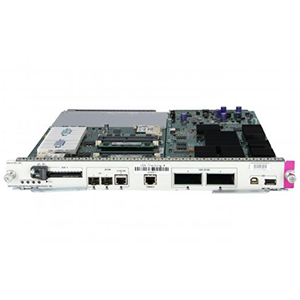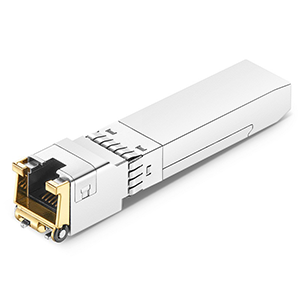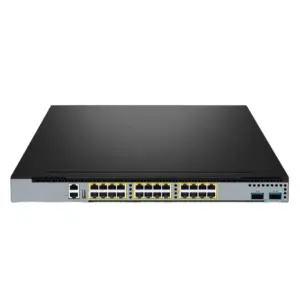SFP (Small Form Factor Pluggable) optical modules play an important role in high-speed optical networks. This article will compare the differences between SFP 10Gb SR and SFP 10Gb SR S. We will first explain the basic working principle and application scenarios of SFP modules and explain its advantages in high-speed Ethernet. Next, we will define the technical specifications of SFP 10Gb SR and explain its main features, advantages and disadvantages.
Then, we will define the technical specifications of SFP 10Gb SR S and explain its main features, advantages and disadvantages. Finally, we will focus on comparing the differences between SFP 10Gb SR and SFP 10Gb SR S in terms of transmission distance, operating temperature, power consumption, cost, and application scenarios, and explain the impact of these differences on network deployment.
Overview of SFP optical module
Basic working principle and application scenarios of SFP module:
SFP (Small Form-factor Pluggable) optical module is a miniaturized photoelectric conversion module, which is widely used in high-speed optical fiber communication networks. Its basic working principle is as follows:
- At the transmitting end, the SFP module receives the electrical signal from the device and converts it into an optical signal and outputs it to the optical fiber.
- At the receiving end, the SFP module converts the optical signal received from the optical fiber back into an electrical signal for use by the device.
- The SFP module integrates key photoelectric devices such as lasers, photodiodes, and power monitoring to realize the photoelectric conversion function.
SFP modules are widely used in the following scenarios:
- Optical interfaces of network devices such as routers and switches
- Optical transmission equipment and fiber-optic communication systems
- Optical connections of data centers and enterprise networks
- Optical transmission fronthaul of 2G/3G/4G/5G base stations
SFP modules have become the standard interface in high-speed optical communication networks due to their small size, low power consumption, and fast plug-in.
Advantages of SFP modules in high-speed Ethernet:
SFP optical modules have the following main advantages in high-speed Ethernet networks:
(1) High-speed transmission capability:
- SFP supports a variety of high-speed Ethernet interfaces such as 1G, 2.5G, 4G, 8G, 10G, and 16G.
- It can meet the bandwidth requirements of applications ranging from Gigabit Ethernet to 10/16G Ethernet.
(2) Low power design:
- SFP modules are highly integrated and consume only 1-2W of power, making them suitable for compact switches and routers.
- Low power consumption helps reduce operating costs and improve heat dissipation.
(3) Modularity and pluggability:
- SFP adopts a standardized modular design to facilitate equipment upgrades and maintenance.
- The pluggable feature enables SFP modules to be quickly replaced and flexibly deployed.
(4) Multiple transmission media:
- SFP supports multiple transmission media such as optical fiber and cable to meet the needs of different application scenarios.
- The available transmission distance ranges from a few hundred meters to tens of kilometers.
In short, SFP optical modules have become the preferred interface in high-speed Ethernet networks with their excellent transmission performance, low power consumption, modularity and other characteristics, and are widely used in various network devices and systems.
SFP 10Gb SR
Technical specifications of SFP 10Gb SR:
SFP 10Gb SR (SFP 10 Gigabit Short Reach) is an SFP optical module standard that supports 10Gbps Ethernet transmission. It mainly follows the following technical specifications:
- Transmission rate: supports Ethernet data transmission of up to 10Gbps.
- Optical wavelength: uses a vertical cavity surface emitting laser (VCSEL) with a wavelength of 850nm.
- Transmission distance: supports up to 300 meters of optical fiber link transmission.
- Power consumption: generally between 1-2W.
- Size: consistent with the size of the standard SFP module, compact.
- Interface: uses the standard SFP optical fiber interface.
In general, SFP 10Gb SR is based on the basic design of the SFP module and realizes 10Gbps Ethernet high-speed transmission.
Main features of SFP 10Gb SR:
(1) Support 10Gbps Ethernet transmission:
- SFP 10Gb SR can provide a maximum Ethernet transmission bandwidth of 10Gbps.
- Meet the bandwidth requirements of high-speed Ethernet applications.
(2) Applicable to short-distance fiber links:
- SFP 10Gb SR supports a maximum fiber transmission distance of 300 meters.
- Applicable to short-distance Ethernet application scenarios such as data centers and campus networks.
(3) Working wavelength 850nm:
- SFP 10Gb SR uses a VCSEL laser with a wavelength of 850nm.
- This wavelength has lower fiber attenuation, which is beneficial for short-distance transmission.
Analysis of the advantages and disadvantages of SFP 10Gb SR:
Advantages:
- Relatively low cost: Based on the mature SFP standard, the cost is better than other 10G Ethernet interfaces.
- Easy to deploy: It can directly replace the existing SFP interface without major changes to network equipment.
Disadvantages:
- Limited transmission distance: It only supports 300 meters of optical fiber transmission, which cannot meet the needs of wide area networks.
- Not suitable for long-distance applications: It cannot replace 10G Ethernet interfaces that support longer transmission distances.
In short, SFP 10Gb SR has advantages in cost and deployment convenience, and is suitable for short-distance Ethernet applications such as data centers and campus networks. However, its transmission distance is limited and cannot meet wide area network applications that require longer transmission distances. Network planners need to reasonably choose SFP 10Gb SR or other 10G Ethernet interfaces based on specific needs.
SFP 10Gb SR S
Technical specifications of SFP 10Gb SR S:
SFP 10Gb SR S (SFP 10 Gigabit Short Reach/Intermediate Reach) is an enhanced SFP optical module standard that supports 10Gbps Ethernet transmission. Its main technical specifications are as follows:
- Transmission rate: supports up to 10Gbps Ethernet data transmission.
- Optical wavelength: uses 850nm wavelength vertical cavity surface emitting laser (VCSEL).
- Transmission distance: supports short-distance optical fiber links up to 300 meters and medium-distance optical fiber links up to 10 kilometers.
- Power consumption: generally between 1.5-2.5W.
- Size: consistent with the size of the standard SFP module, compact.
- Interface: Standard SFP fiber interface.
Compared with the basic SFP 10Gb SR, SFP 10Gb SR S has improved transmission distance and performance.
Main features of SFP 10Gb SR S:
(1) Support 10Gbps Ethernet transmission:
- SFP 10Gb SR S can provide a maximum Ethernet transmission bandwidth of 10Gbps.
- Meet the bandwidth requirements of high-speed Ethernet applications.
(2) Suitable for short-distance and medium-distance fiber links:
- SFP 10Gb SR S supports short-distance fiber transmission of up to 300 meters and medium-distance fiber transmission of up to 10 kilometers.
- Compared to SFP 10Gb SR, it supports a wider range of optical fibers, meeting the needs of more application scenarios.
(3) Working wavelength 850nm:
- SFP 10Gb SR S uses a VCSEL laser with a wavelength of 850nm, which is consistent with SFP 10Gb SR.
- This wavelength has lower optical fiber attenuation, which is beneficial for short and medium-distance transmission.
Analysis of the advantages and disadvantages of SFP 10Gb SR S:
Advantages:
- Longer transmission distance: supports medium-distance optical fiber link transmission up to 10 kilometers, which is significantly improved compared to SFP 10Gb SR.
- Better performance: Compared with the basic model, it has higher transmission reliability and stability.
Disadvantages:
- Slightly higher cost: Compared with SFP 10Gb SR, the purchase cost of SFP 10Gb SR S is slightly higher.
- Slightly higher power consumption: The power consumption of SFP 10Gb SR S is between 1.5-2.5W, which is slightly higher than that of SFP 10Gb SR.
In short, SFP 10Gb SR S has improved transmission distance and performance compared with the basic model, and is more suitable for scenarios that need to cover medium and short-distance Ethernet applications. However, its slightly higher cost and power consumption also need to be weighed. Network planners should choose the appropriate SFP 10Gb model according to specific application requirements.
Comparison of the differences between SFP 10Gb SR and SFP 10Gb SR S
The main differences between SFP 10Gb SR and SFP 10Gb SR S are transmission distance and fiber type. SFP 10Gb SR (Short Range) is usually suitable for shorter transmission distances, such as 300 meters, using multimode fiber; while SFP 10Gb SR S (Short Range S) is designed for shorter distances, usually within 100 meters, optimizing the performance of short-distance transmission.
Transmission distance:
- SFP 10Gb SR supports short-distance fiber transmission up to 300 meters.
- SFP 10Gb SR S supports short-distance transmission up to 300 meters and medium-distance transmission up to 10 kilometers.
- SFP 10Gb SR S supports a wider transmission distance and can meet the needs of different application scenarios such as data centers and campus networks.
Operating temperature:
- The operating temperature range of SFP 10Gb SR is generally 0~70°C.
- The operating temperature range of SFP 10Gb SR S is wider, usually -5~85°C.
- A wider operating temperature range can improve the reliability and adaptability of SFP 10Gb SR S.
Power consumption:
- The power consumption of SFP 10Gb SR is generally between 1-2W.
- The power consumption of SFP 10Gb SR S is slightly higher, between 1.5-2.5W.
- The slightly higher power consumption of SFP 10Gb SR S requires the equipment to have a better heat dissipation design.
Cost:
- The procurement cost of SFP 10Gb SR is relatively low.
- The cost of SFP 10Gb SR S is slightly higher than the basic model, usually about 20% higher.
- The cost difference may affect the investment decision of network deployment.
Application scenario:
- SFP 10Gb SR is more suitable for short-distance Ethernet applications such as data centers and campus networks.
- SFP 10Gb SR S can cover Ethernet applications from short to medium distances, such as metropolitan area networks.
- Users need to choose the appropriate SFP 10Gb model based on specific network requirements and budgets.
In short, SFP 10Gb SR and SFP 10Gb SR S have certain differences in transmission distance, operating temperature, power consumption and cost. These differences determine their applicability in different Ethernet applications. Network planners need to consider these factors comprehensively and choose the SFP 10Gb solution that best meets their needs.
Summary
SFP optical modules are key components for building high-speed Ethernet. It is crucial to choose the right SFP 10Gb SR or SFP 10Gb SR S. Our company has long focused on the research and development and application of SFP modules and has rich practical experience. We provide various high-performance SFP 10Gb SR and SFP 10Gb SR S products are widely used in campus networks, enterprise networks, data centers and other fields.
Our SFP modules adopt industry-leading technology and have achieved excellent levels in transmission performance, power consumption, reliability and other aspects. At the same time, our engineering team will provide you with professional demand analysis and product selection services to ensure that the selected SFP modules can meet your actual needs to the greatest extent. Contact us now to learn more. We will do our best to provide you with the best quality products and solutions.
SFP 10gb SR and SFP 10gb SR S FAQ
An SFP 10G SR (Short Range) module is a type of optical transceiver designed to operate over short distances, typically up to 300 meters, using multimode fiber (MMF) with a wavelength of 850 nm.
An SFP 10G SR S module is a variant of the SFP 10G SR module that is designed for improved performance and additional features. The “S” in SR S typically indicates enhanced specifications or support for specific applications.
Both SFP 10G SR and SFP 10G SR S modules are designed for short-range applications, generally supporting distances up to 300 meters. The SR S module may have enhancements for better performance or slightly different range capabilities.
Both SFP 10G SR and SFP 10G SR S modules operate at an 850 nm wavelength, which is suitable for short-range communication over multimode fiber.
SFP 10G SR S modules may have improved power efficiency compared to standard SFP 10G SR modules. Specific power consumption details can vary depending on the manufacturer and design.
Both modules typically use LC duplex connectors for multimode fiber. Any differences in connector types would be specified by the manufacturer.
The SFP 10G SR S module may offer enhancements such as improved signal integrity, better thermal performance, and support for additional features like digital diagnostics or extended temperature ranges.
SFP 10G SR S modules are generally more expensive than standard SFP 10G SR modules due to their enhanced features and performance specifications.
While both modules are designed for short-range applications, you should check compatibility with your network equipment. In many cases, SFP 10G SR and SR S modules can be used interchangeably if they meet the required specifications.
Choose SFP 10G SR modules for basic short-range connectivity needs. Opt for SFP 10G SR S modules if you require enhanced performance, such as improved signal quality, energy efficiency, or specific features for your application. Consider your network’s performance requirements and budget when making the decision.




